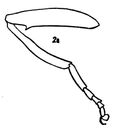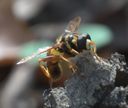Milesia
Milesia
Classification
- Phylum: Arthropoda
- Subphylum: Hexapoda
- Class: Insecta
- Order: Diptera
- Family: Syrphidae
- Subfamily: Eristalinae
- Tribe: Milesiini
- Subtribe: Milesiina
- Genus: Milesia
Pronunciation
How to pronounce Milesia: /mɪˈleɪziə/
These audio files are automatically generated. While they are not always 100% accurate, they are a good starting point.
Images






Summary
Milesia is a genus of large hoverflies known for their mimicry of wasps, commonly found worldwide with a notable presence in southern Asia. Their larvae play a role in the decomposition process by feeding on decaying wood.
Physical Characteristics
Large syrphids with cylindrical bodies, mimic wasps, particularly hornets. They have a buzzy flight, likely due to mimicry.
Identification Tips
Look for their large size and cylindrical shape; they resemble wasps in appearance.
Habitat
Larvae feed on wet decaying heartwood in rot-holes.
Distribution
Worldwide, with the highest diversity found in southern Asia. In the studied area, one species is widespread in the east, another in the southeastern U.S. (NC-FL-TX), and one in the southwestern U.S. (AZ-NM).
Diet
Larvae feed on wet decaying heartwood in rot-holes.
Life Cycle
Active during summer; M. virginiensis observed from May to September (to November at low elevations), and M. scutellata from May to June.
Ecosystem Role
Pollinators and decomposers due to their larvae feeding on decaying material.
Similar Taxa
Misconceptions
Due to their mimicry of wasps, they may be mistaken for hornets and bees; however, they do not sting.
Tags
- Milesia
- hoverfly
- syrphid
- insect
- Diptera